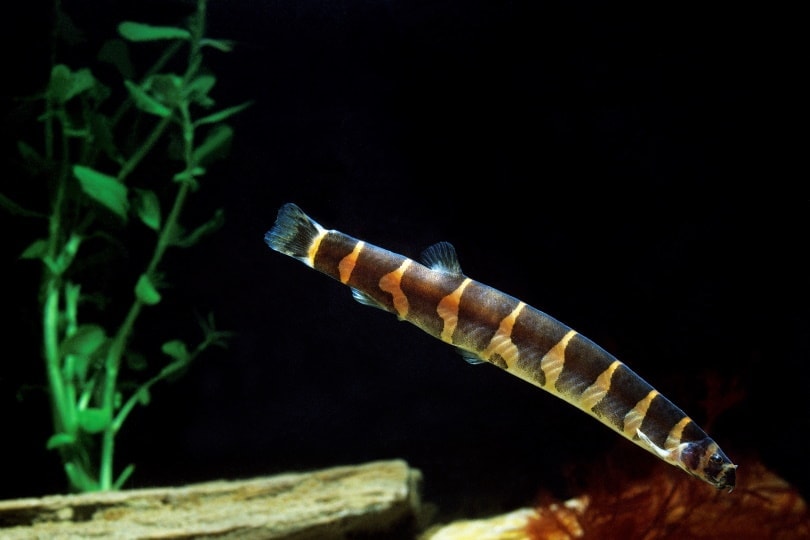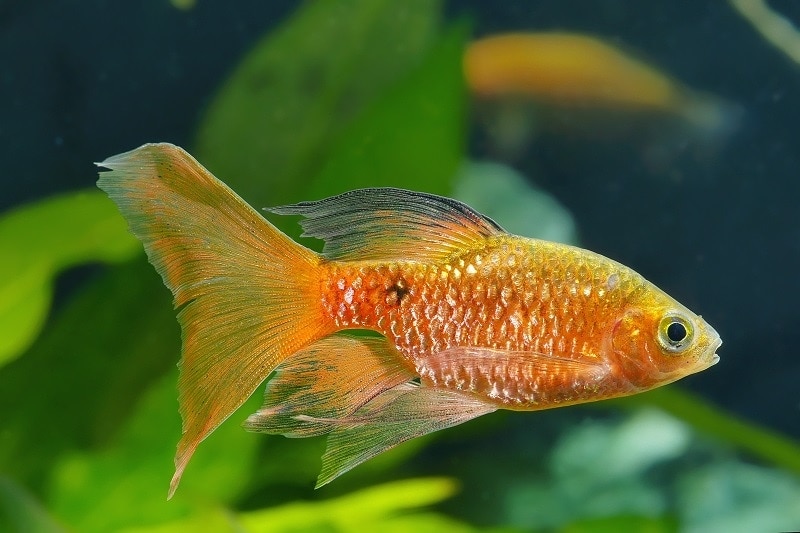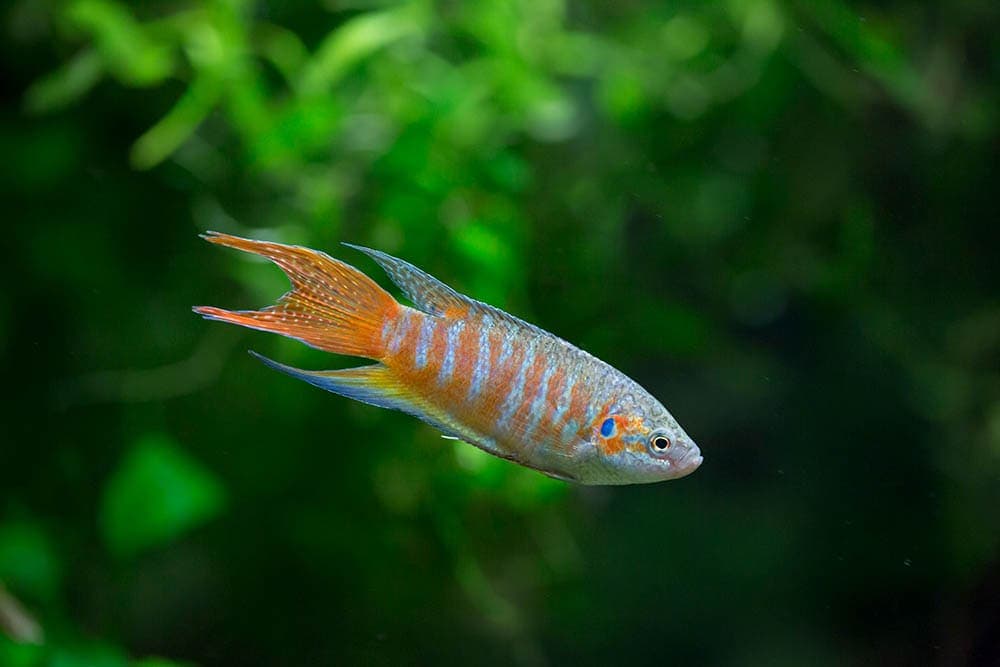10 Safe Tank Mates for Dojo Loaches: Compatibility Guide 2024

Updated on

Dojo Loaches, also known as Weather Loaches or Pond Loaches, are unique fish to have in a home aquarium. They are easy to care for, making them great for beginners, and they are endlessly fascinating to watch. They are most well-known for their unique response to weather changes and will often swim erratically or even vertically when they sense a storm approaching. Dojo Loaches are hardy creatures that don’t have any complicated tank requirements, and they have become hugely popular fish for beginners and experts alike.
A part of the joy of owning a home aquarium is watching several species of fish swim and coexist, so you’ll want to add a few tank mates for your Dojo Loach. But what are the correct tank mates for Dojo Loaches? Since these fish are so hardy and docile, there is a wide variety of suitable ones to choose from. In this article, we look at 10 of our favorites.
The 10 Tank Mates for Dojo Loaches
1. White Cloud Minnows (Tanichthys albonubes)

| Size | 1–2 inches (2.5–3 cm) |
| Diet | Omnivore |
| Minimum tank size | 10 gallons (37 liters) |
| Care Level | Easy |
| Temperament | Peaceful |
White Cloud Minnows make ideal tank mates for Dojo Loaches because they are small and peaceful, and they are hardy and easy to care for. These small fish prefer the bottom of the tank and do not bother much with other fish around them — provided that they have enough tank space. Without this, they can become aggressive at times. They prefer to live in small groups, so you should have at least three to five minnows per tank.
2. Kuhli Loach (Pangio kuhlii)

| Size | 3–5 inches (7.5–12.7 cm) |
| Diet | Omnivore |
| Minimum tank size | 15 gallons (56 liters) |
| Care Level | Intermediate |
| Temperament | Peaceful |
The Kuhli Loach, also known as a Leopard Loach, is an eel-like, peaceful fish that makes a great tank mate for a Dojo due to its shy and docile nature. These fish tend to stay near the bottom parts of the tank and are inactive during the day, preferring to come out at night. They enjoy the company of other loaches, and along with your Dojo Loaches, it’s a good idea to keep three or four Kuhuli Loaches together.
Related Read: 10 Best Tank Mates for Kuhli Loach
3. Goldfish (Carassius auratus)

| Size | 1–6 inches (2.5–15 cm) |
| Diet | Omnivore |
| Minimum tank size | 20 gallons (75 liters) |
| Care Level | Easy |
| Temperament | Peaceful |
Goldfish are among the easiest aquarium fish to care for and among the most placid, making them ideal tank mates for your Dojo. They generally stay fairly small but can reach up to 6 inches long if given enough space. They are non-aggressive fish that will not cause your Dojos any trouble and are beautiful additions to any community aquarium.
4. Zebra Danios (Danio rerio)

| Size | 1–2 inches (2.5–5 cm) |
| Diet | Omnivore |
| Minimum tank size | 10 gallons (37 liters) |
| Care Level | Easy |
| Temperament | Peaceful |
Zebra Danios, or Zebra Fish, are among the most popular fish for freshwater aquariums because they’re so easy to care for. They are rarely aggressive, making them ideal Dojo tank mates. They are adaptable fish that can live in various aquarium conditions, but they prefer to live in small schools of at least four or five.
If their numbers are too low, they can begin to act rather strangely, including possible aggression. Since they prefer the surface part of your tank, they should stay well out of your Dojo’s way.
5. Harlequin Rasboras (Trigonostigma heteromorpha)

| Size | 1–2 inches (2.5–5 cm) |
| Diet | Omnivore |
| Minimum tank size | 10 gallons (37 liters) |
| Care Level | Easy |
| Temperament | Peaceful, easily stressed |
Also known as the Red Rasbora in the pet trade, the Harlequin Rasbora is a peaceful fish with beautiful metallic colors and makes a striking addition to community tanks. These fish are primarily shoaling fish and are easily stressed if kept in groups that are too small, so you’ll need at least eight to 10 individuals to keep them happy.
They are great fish for any tank because they are small and non-predatory, so they will not nip or fight with your Dojos.
6. Leopard Danios (Danio rerio)

| Size | 1–2 inches (2.5–5 cm) |
| Diet | Omnivore |
| Minimum tank size | 10 gallons (37 liters) |
| Care Level | Intermediate |
| Temperament | Peaceful, active |
The Leopard Danio is a distinct variety of the Zebra Danio, but with spots instead of stripes. They are peaceful fish and favorites among freshwater aquarium keepers. They can make great tank mates for a variety of fish, including Dojos. They are active and energetic fish, making them a joy to observe in your aquarium, especially when kept in small schools.
7. Rosy Barbs (Pethia conchonius)

| Size | 4–6 inches (10–15 cm) |
| Diet | Omnivore |
| Minimum tank size | 30 gallons (113 liters) |
| Care Level | Moderate |
| Temperament | Peaceful, shy |
The Rosy Barb, or Red Barb, is a somewhat shy and peaceful fish that prefers its own space, and it is a great addition to your Dojo’s tank. It is one of the larger species of barbs, but they are fairly active and energetic fish, so they are fascinating to watch.
These fish prefer to live in small schools, so you’ll need at least five in your tank. They socialize well with several species, and they are among the most popular additions to community tanks.
8. Bichir (Polypteridae)

| Size | 11–23 inches (27–58 cm) |
| Diet | Carnivore |
| Minimum tank size | 40 gallons (150 liters) |
| Care Level | Intermediate |
| Temperament | Mostly peaceful, can get aggressive |
The Bichir is a bottom-dwelling fish that generally only comes out at night. They are unique-looking fish indeed, with large dorsal fins and a reptilian appearance. They are hardy fish that can happily survive in brackish water. Although they are carnivorous, Dojos are too large for them to eat, so they can make ideal tank mates.
They have long lifespans and need access to the top of the tank to breathe oxygen, making them slightly more of a challenge to care for.
9. Paradise Fish (Macropodus opercularis)

| Size | 2–3 inches (5–7.5 cm) |
| Diet | Omnivorous, but largely carnivorous |
| Minimum tank size | 20 gallons (75 liters) |
| Care Level | Easy |
| Temperament | Mostly peaceful but occasionally aggressive |
Paradise fish are active, easy-to-care-for, and beautiful creatures that make great additions to any community aquarium, including with your Dojos. They have a reputation for aggression, but it is largely among males competing in the same school, so males should not be kept together. As long as Paradise Fish are kept with fish that are bigger than them or do not pose a threat, they will usually be fine, so they can be housed with Dojos without any issues.
10. Gold Spot Dwarf Pleco (Pterygoplichthys joselimaianus)
| Size | 1–2 inches (2.5–5 cm) |
| Diet | Omnivore |
| Minimum tank size | 10 gallons (37 liters) |
| Care Level | Easy |
| Temperament | Peaceful, calm |
The Gold Spot Dwarf Pleco is a beautiful fish, and with its calm, docile personality and tendency to keep to itself, it is a great addition to a community tank. These fish are visually striking but easy to care for, and you will hardly see them moving except at night when they tend to be more active. These docile fish will pretty much ignore all the other fish in their tank, although they can get territorial with other catfish species at times.
What Makes a Good Tank Mate for Dojo Loaches?
Dojo Loaches are peaceful, docile fish that tend to mind their own business and prefer the bottom areas of a tank, and any non-aggressive fish that keep to the middle and top layers of your aquarium can be great tank mates. While Dojo Loaches can be kept alone, they do best in small groups of three or four fish.
They can become rather social with other peaceful fish, and you may even see them playfully chasing one another around the tank. In general, any fish that won’t cause much trouble can make good tank mates for Dojos.
Where Do Dojo Loaches Prefer to Live in the Aquarium?
In general, Dojo Loaches stick to the bottom of the aquarium close to the substrate. They enjoy burrowing, so they should be given a nice loose substrate that they can dig into. In their natural habitat, they tend to live in areas with plenty of loose-leaf litter on the floor, where they can burrow and hide to feel safe. This should be replicated as much as possible in captivity.
Water Parameters
Dojo Loaches are native to most of eastern Asia, including Japan and China, where they are a popular food source. They favor small, slow-moving streams, rice paddies, ponds, and marshes. They are fairly tolerant of a wide range of water parameters and can happily live in water temperatures between 50 degrees Fahrenheit and 82 degrees Fahrenheit, but between 65 degrees Fahrenheit and 75 degrees Fahrenheit is preferable, with a pH of 6.5 to 8.0.
Size
In captivity, Dojo Loaches generally do not reach more than 6 inches long, but they can get surprisingly long if given enough space. In the wild, the fish can get almost double this size, and some have been seen as long as 12 inches when fully grown! Dojos have a lifespan of up to 10 years, and they can reach impressive lengths.
Aggressive Behaviors
Most Dojo Loaches are peaceful and non-aggressive toward other fish, although some aquarists have seen them nipping fins occasionally. This is most likely due to either a lack of food or hiding spots. If you’ve noticed your Dojo acting aggressively, try adding a looser substrate so they can burrow or add more hiding spots. You may also need to feed them a bit more.
The Benefits of Having Tank Mates for Dojo Loaches in Your Aquarium
Dojo Loaches are generally docile fish that prefer to do their own thing, but as any Dojo keeper will tell you, they can get fairly active, playful, and social at times, and they will love to have a variety of tank mates to engage with. Having diversity in your tank will appeal to a fish’s natural instincts and make them feel more at home. It also looks far more visually appealing!
Conclusion
Since Dojo Loaches are such peaceful, docile fish in general, there is a wide variety of potential tank mates for them. They tend to stick to the bottom of the aquarium, where they can hide and burrow, so any non-aggressive fish that prefer the middle or top layers of the tank can be successfully kept with Dojos. While there are plenty of Dojo tank mate options, this list has 10 of our favorites. Hopefully, you’ve found a few Dojo tank mates that appeal to your home aquarium.
- See also: Best Tank Mates for Yoyo Loaches
Featured Image Credit: Piqsels










